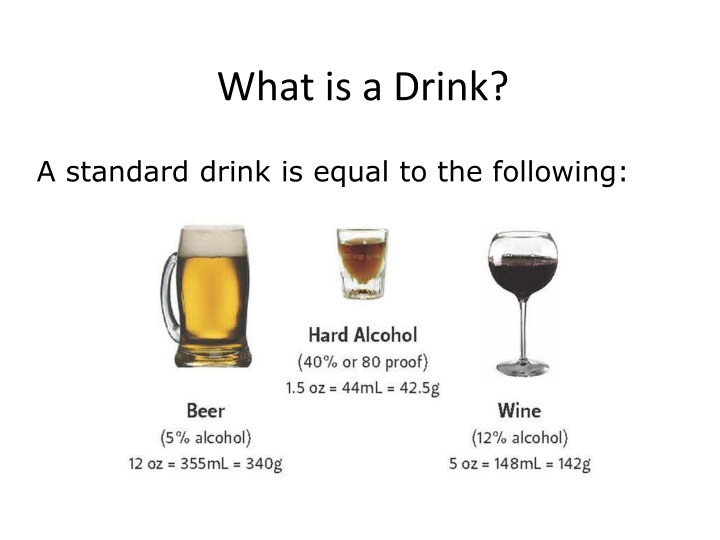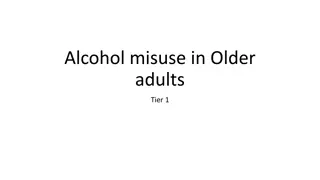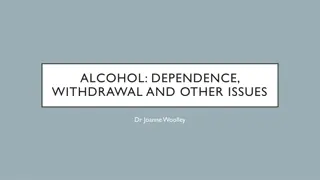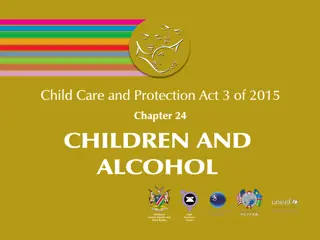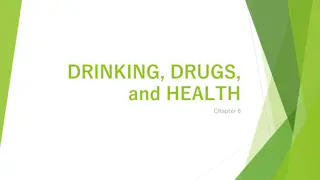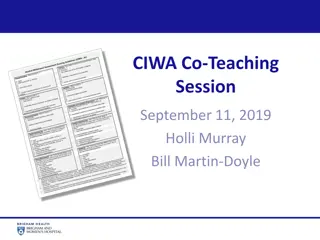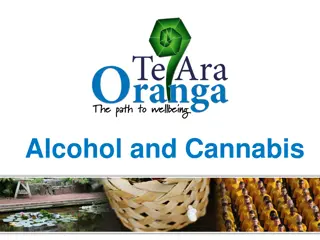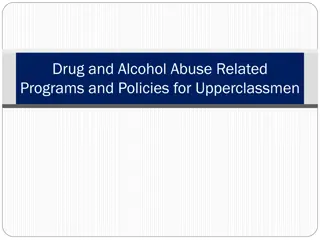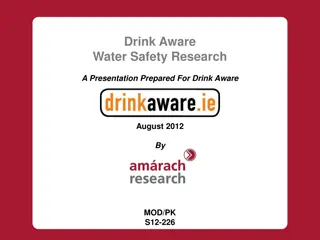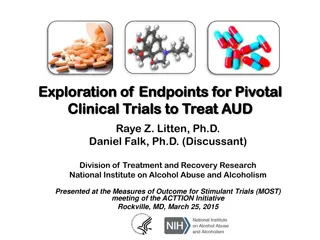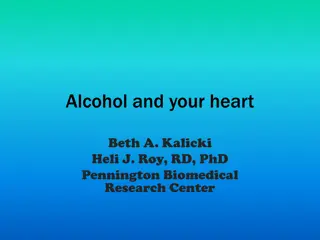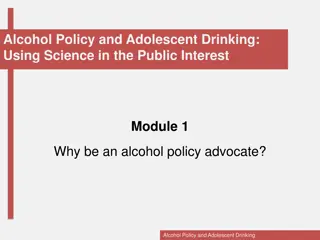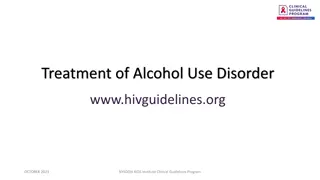Alcohol Awareness and Safety Tips for Students
Understand the concept of a standard drink, the risks associated with jungle juice, effects of tolerance, dangers of alcohol poisoning, and strategies to reduce negative consequences when consuming alcohol. Remember to always prioritize safety and make informed choices regarding alcohol consumption, especially in social settings.
Uploaded on Oct 04, 2024 | 1 Views
Download Presentation

Please find below an Image/Link to download the presentation.
The content on the website is provided AS IS for your information and personal use only. It may not be sold, licensed, or shared on other websites without obtaining consent from the author.If you encounter any issues during the download, it is possible that the publisher has removed the file from their server.
You are allowed to download the files provided on this website for personal or commercial use, subject to the condition that they are used lawfully. All files are the property of their respective owners.
The content on the website is provided AS IS for your information and personal use only. It may not be sold, licensed, or shared on other websites without obtaining consent from the author.
E N D
Presentation Transcript
What is a Drink? A standard drink is equal to the following:
Possible Converted Standard Drink Measures Beer (2nd from top line) Wine (2nd from bottom line) 80 Proof Liquor (Bottom Line)
Jungle Juice Jungle juice has no one way to be created. The amount of alcohol depends on how much alcohol is put into the juice. Once they mix together, there is no way to know how much alcohol is in one cup of jungle juice. It s also impossible to determine if there are predatory drugs like GHB, Ketamine or Rohypnol in the jungle juice. Since jungle juice is not regulated, more alcohol can be added throughout the night, making the drink more alcoholic or less alcoholic. Without a clear understanding of how much alcohol someone is drinking, it is easy to become dangerously intoxicated. Grain alcohol can be added to jungle juice. It is approximately 95% alcohol.
Tolerance and the Environment A person build s their tolerance to alcohol based on the environment they are used to drinking in. If a person s environment changes, their tolerance disappears. This is called Situational Specificity. Drinking a lot during spring break, depending on environment changes, can have serious negative consequences.
How Tolerance Works CNS Stimulatio n (CNS Speeds Up) Drink to Buzz Drink to Buzz Drink to Buzz Drink to Buzz Tolerance Tolerance Tolerance Drink to Buzz Tolerance Environment Change Tolerance Tolerance Drink to Buzz Drink to Buzz Baseline Drink to Buzz Drink to Buzz Drink to Buzz Desired Feeling Buzzed Drink to Buzz CNS Depression (CNS Slows Down)
Alcohol Poisoning Acute alcohol poisoning is an emergency. Make the call! Too much alcohol will kill a person. Never leave an intoxicated person alone.
Reducing Negative Consequences Staying Safe Strategies Consuming any amount of alcohol increases the risk for negative consequences. It is highly recommended that students refrain from consuming alcohol. Avoid drinking games, shots and jungle juice Drink alcohol look-alike beverages Alternate alcoholic and non- alcoholic drinks Pace drinks throughout night Set a limit ahead of time and stick to it Keep track of the number of drinks Have a Designated Driver or call for a ride Eat before/during If a student chooses to drink alcohol, here are some strategies to help minimize the risk for negative consequences.
Looking for Help? Oregon State has numerous resources for students who would like to explore their drinking habits. All students are encouraged to utilize these campus resources. Student Health Services Health Promotion Department Robert Reff, Substance Abuse Prevention Coordinator Email: robert.reff@oregonstate.edu Phone: 541-737-7564 http://studenthealth.oregonstate.edu/ alcohol-and-other-drugs Counseling and Psychological Services (CAPS) Fifth Floor, Snell Hall Phone: 541-737-2131 http://oregonstate.edu/counsel Completely anonymous feedback on your personal drinking habits. http://studenthealth.oregonstate.edu/echug
Legal Ramifications of Alcohol Furnishing alcohol to a minor No person shall sell, give or make alcohol available to a minor (including another minor). Minor in possession of alcohol (MIP) Possession of alcohol is holding the alcohol have consumed the alcohol attempted to purchase Will be cited to appear in circuit court. Misrepresentation of age by a minor When minors misrepresent their age, they purposely are not truthful about their age to prevent being in violation of the law. Will appear in court Could result in: fines suspended driving privileges (1 year) or wait up to one year to apply an alcohol education course surface on background checks Will be cited to appear in circuit court. Could result in: fines one year driver license suspension
UHDS Alcohol Policy 1. All residents, guests of residents, faculty, and staff are expected to know and abide by all laws and University policies regarding the use of alcohol. Residents and their guests who are under the age of 21 may not possess or consume alcohol. This policy is in accordance with Oregon state law. Residents and their guests may not consume alcohol in the presence of those under the age of 21. It is a violation of policy for anyone under the age of 21 to be present in a room or common area where they know that alcohol is present. Residents who are 21 years of age or older may possess alcohol in individual residence rooms, with the exception of residents who reside in substance-free living environments. The following are guidelines for individual possession for residents 21 years old or older: a) Residents who are at least 21 years of age may not consume alcohol in the room in the presence of individuals, including roommates, who are under the age of 21. b) Residents of legal age must discreetly transport alcohol to their rooms. c) Residents of legal age may only store their alcohol out of view in their assigned area of the room. d) It is also a violation of housing policy to provide alcohol to anyone under 21 or to anyone regardless of age who is visibly intoxicated. Students regardless of age who exhibit behaviors that appear to have been influenced by alcohol may be subject to disciplinary action. Such behaviors may include but are not limited to slurred speech, smell of alcohol, and lack of balance or swaying. Individuals under 21 years of age and all residents living in Substance Free Living Environments, regardless of age, may not display and/or possess alcohol containers (empty or full) within UHDS facilities or grounds. Open containers of alcohol are not permitted in public or common areas either inside or outside of residential buildings. Common areas include, but are not limited to, outside entry or adjacent sidewalk areas, all lounges, lobbies, kitchenettes, recreation rooms, entertainment areas, hallways, bathrooms, stairways, fire exits, elevators, and laundry rooms, and a student room with an open door. Common source containers (e.g. keg) and rapid consumption devices (e.g. beer bongs) are prohibited. 2. 3. 4. 5. 6. 7. 8.
Drinking in the Sun Alcohol dehydrates the body of water Drinking in the sun can lead to someone becoming dehydrated much quicker than they are used to either by sun or by alcohol If someone is drinking in the sun, it is important to understand how quickly one can become dehydrated
Student Conduct Code (10) Alcohol violations, including possession or consumption of alcohol by persons less than 21 years of age, furnishing alcohol to persons less than 21 years, or consumption of alcohol by a Student of any age in violation of the University s rules or policies on alcoholic beverages on University owned or controlled property or at University sponsored or supervised activities.
